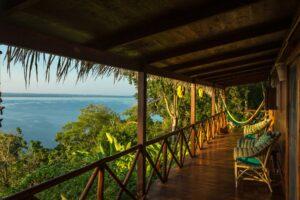Fodor's Expert Review Yaxhá
Yaxhá is part of the Yaxhá-Nakúm-Naranjo Natural Monument. Though less expansive than Tikal, many report preferring its intimacy. It is relatively easy to reach by car from the Belize border, with a guide tour from San Ignacio, Belize, or by a guided tour from Flores or El Remate. From the Belize border it's about 25 miles (43 km), or an hour, by car, on roads that are passable even in the rainy season. There is a visitor center and small museum here, along with restrooms. It can be seen in about half a day, and wildlife, including spider and howler monkeys, animates its trees. The ruins, built of an unusual light-toned limestone, give it a different feel than most other ruins in the region. Only rarely are there more than a handful of visitors at Yaxhá.
Overlooking a beautiful lake of the same name, the ruins of Yaxhá are divided into two sections of rectangular structures that form plazas and streets.
A guide is a good idea here,... READ MORE
Yaxhá is part of the Yaxhá-Nakúm-Naranjo Natural Monument. Though less expansive than Tikal, many report preferring its intimacy. It is relatively easy to reach by car from the Belize border, with a guide tour from San Ignacio, Belize, or by a guided tour from Flores or El Remate. From the Belize border it's about 25 miles (43 km), or an hour, by car, on roads that are passable even in the rainy season. There is a visitor center and small museum here, along with restrooms. It can be seen in about half a day, and wildlife, including spider and howler monkeys, animates its trees. The ruins, built of an unusual light-toned limestone, give it a different feel than most other ruins in the region. Only rarely are there more than a handful of visitors at Yaxhá.
Overlooking a beautiful lake of the same name, the ruins of Yaxhá are divided into two sections of rectangular structures that form plazas and streets.
A guide is a good idea here, because it is not obvious what all the structures are.
Here's what is known: The city was probably inhabited between the pre-Classic and Classic periods, and at its peak contained 20,000 people. It was also an important ally of nearby Tikal. Only a portion of the estimated 500 structures are visible at present, the most famous of which is designated Templo 216, Yaxhá's highest edifice with splendid views of the adjoining lake and rain forest.
Lake Yaxhá—the name, pronounced yah--shah, translates as "green waters"—surrounded by virgin rain forest, is a good bird-watching spot. In the middle of the lake sit the ruins of Isla Topoxté, a fortress dating from the post-Classic period about AD 1000, and the site of one of the last strongholds against Spanish invaders. Ask the park staff here about transportation. Someone can take you if you pay for the boat's gas. Crocodiles inhabit the lake.
You can camp at Yaxhá, or stay at the solar-powered jungle lodge, Camapmento Ecológico El Sombrero (502/7861–1687) about 1 mile (2 km) south of the Yaxhá ruins.
READ LESS



